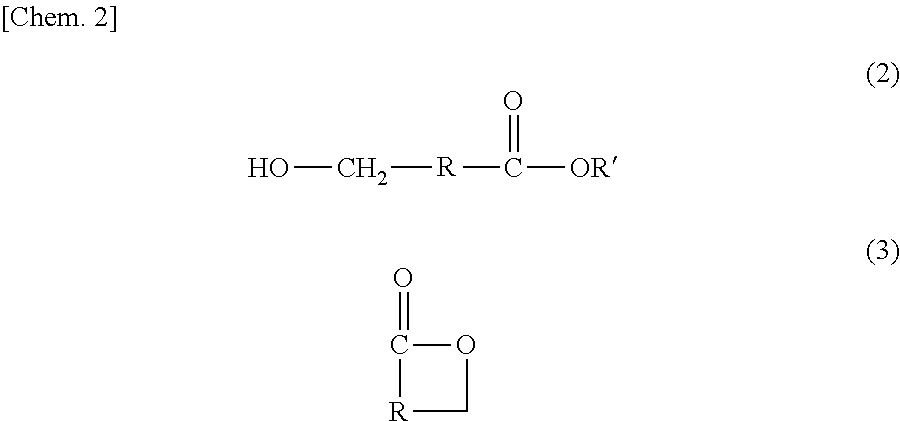Method for producing hydroxycarboxylic acid ester
- Summary
- Abstract
- Description
- Claims
- Application Information
AI Technical Summary
Benefits of technology
Problems solved by technology
Method used
Image
Examples
example 1
Preparation of Catalyst: Co-Impregnation Method
[0103]0.0898 g of H2PtCl6 and 0.0088 g of (NH4)6Mo7O24.4H2O were dissolved in 50 mL of water to prepare a solution; 1 g of hydroxyapatite (HAP, trade name “Tricalcium Phosphate”, available from Wako Pure Chemical Industries, Ltd.) was immersed in the resulting solution for 4 hours under room temperature (25° C.). After immersion, water was distilled off in a rotary evaporator under reduced pressure to prepare a powder. The formed powder was then calcined in an air atmosphere in a muffle furnace at 500° C. for 3 hours to prepare Catalyst (1) [Pt—Mo / HAP, amount of Pt supported: 4 wt. %, amount of Mo supported: 0.485 wt. %, Mo / Pt (molar ratio)=0.25].
examples 2 to 5
[0104]1 mmol of the substrate as described in the table below, 100 mg of Catalyst (1) [Pt that is 2 mol % of the substrate, Mo that is 0.5 mol % of the substrate (in terms of metal)], and 3 mL of water were charged in an autoclave having a Teflon (trade name) inner cylinder and reacted at 110° C. for a number of hours as described in the table below under the condition of hydrogen pressure of 5 MPa to produce reaction products. The conversion ratio (conv. [%]) of the substrate was measured using HPLC, and the yield of each one of the reaction products was measured using a gas chromatograph mass spectrometer (GC-MS).
[0105]The results are summarized and shown in the table below.
TABLE 1timeconversionproduct yieldentrysubstrate(h)(%)(%)218>99314>99412>9951896
[0106]To summarize the above, configurations and variations according to an embodiment of the present invention will be described below.
[0107][1] A method for producing a hydroxycarboxylic acid ester, the method including reducing a...
PUM
| Property | Measurement | Unit |
|---|---|---|
| Fraction | aaaaa | aaaaa |
| Fraction | aaaaa | aaaaa |
| Fraction | aaaaa | aaaaa |
Abstract
Description
Claims
Application Information
 Login to View More
Login to View More - R&D
- Intellectual Property
- Life Sciences
- Materials
- Tech Scout
- Unparalleled Data Quality
- Higher Quality Content
- 60% Fewer Hallucinations
Browse by: Latest US Patents, China's latest patents, Technical Efficacy Thesaurus, Application Domain, Technology Topic, Popular Technical Reports.
© 2025 PatSnap. All rights reserved.Legal|Privacy policy|Modern Slavery Act Transparency Statement|Sitemap|About US| Contact US: help@patsnap.com



